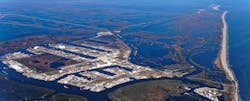Port Fourchon champions offshore energy, the environment
For 61 years, Port Fourchon has been the Gulf of Mexico’s premier service station for the offshore oil and gas industry. Today the port, which spans 1,700 acres, services all the energy production in the deepwater Gulf of Mexico.
In addition to the pandemic, market downturn, and new administration, the port faced Hurricane Zeta and five other hurricanes/tropical storms last year. Despite these challenges, Port Fourchon continues to evolve, expand, and enhance not only industrial capabilities but also the environment.
According to Greater Lafourche Port Commission (GLPC) Executive Director Chett Chiasson, resiliency is key. “We’re very proud of the fact that we can balance ourselves in terms of playing a role in providing energy for our country,” he said, “as well as being an example of how you can also utilize the assets, people, and the material you dredge to enhance habitat and the environment.”
New logo
At the beginning of the year, the GLPC launched its Fourchon logo with assistance from White Car, a Thibodaux, Louisiana-based brand consultancy agency.
“It’s a rebrand. It’s something to take us into the future,” Chiasson said. “We knew that the landscape in the country was changing, and we wanted to make sure that our brand was clean, sleek, and revived to have us open to whatever opportunities come our way.”
The central theme of the gold logo highlights the grid-like development of Port Fourchon, where bulkheads intertwine with the adjacent waterways of Bayou Lafourche and the Gulf of Mexico. The blocks depict the solid nature of the port that has resulted through advanced mitigation techniques.
“Most people don’t call it Port Fourchon. The people that work here every day call it Fourchon,” he said. “So, we wanted to play on what everybody knows us as, and what everybody calls us.”
The main Fourchon logo is only one of several subset logos that showcase the GLPC and its assets such as: Harbor Police, the South Lafourche “Leonard J. Miller, Jr.” Airport, and the Coastal Wetlands Park. The subset logos feature a green line because the color was used in Fourchon’s two previous logos.
COVID and market update
Between March 2020 and March 2021, the port lost $9.5 million in revenue due to COVID-19 and its impact on the economy and energy demand, according to Chiasson. However, Fourchon is in good shape.
“We were able to hold off having mass shutdowns. People did a good job of responding and keeping everybody safe,” he said. “The entire port community did a really good job staving off any major issues. We’re very proud of that.”
Chiasson says that he is cautiously optimistic about the state of the market.
“What concerns us is the lack of exploratory drilling,” he said. “That’s really where the major business is. That’s where the need for all the services is.”
As the energy transition and US offshore wind market gain momentum, Chiasson said the country needs a realistic energy portfolio.
“We want a balanced approach, and we want to be a part of whatever is happening in terms of offshore energy,” he said. “The Gulf of Mexico should always be seen as an offshore energy hub.”
Expansion projects
Meanwhile, Fourchon continues to expand to serve the needs of the industry and the community.
After the GLPC funded the Section 203 Feasibility Study, Congress passed the Water Resources Development Act of 2020 last December. This gave the port authorization to begin dredging Belle Pass, Bayou Lafourche, and the Northern Expansion to 30 ft (9 m) in the coming years.
According to Chiasson, the ultimate goal is to dredge Belle Pass to 50 ft (15 m). This will allow for the development of the Fourchon Island project and the establishment of a deepwater rig repair and refurbishment facility. The project is in the conceptual phase, he said.
An LNG facility is on the horizon for development on West Belle Pass in the port. “We are keeping our fingers crossed that construction of the LNG plant will be nearing completion in about three years,” Chiasson said.
Development also continues on Slip D. The 1,000-ft (305-m) wide slip will add about 200 acres of developed property to the port and more than 10,000 linear ft of waterfront.
As part of the mitigation of Slip D, the GLPC was mandated to create 60 acres of marsh but had enough material for about 100. As a result, the port commission decided to establish a recreational and educational area known as the Coastal Wetlands Park. It will feature access to a man-made tidal creek for kayaking and non-motorized vessels, a two-story orientation hub with viewfinders, walking trails, boardwalks, and more. The park is expected to be open to kayakers this summer.
“We’ve been able to do all of this because of industry, not in spite of industry,” Chiasson said.
Improving LA 1
LA 1 is the only highway that services Fourchon. According to the LA 1 Coalition, more than 1,200 trucks and heavy vehicles travel the LA 1 southern corridor daily to support port activity and energy production.
On June 8, 2020, flooding from Tropical Storm Cristobal forced the highway to be closed for 20 hours. One week later, the US Department of Transportation awarded a $135-million Infrastructure for Rebuilding America (INFRA) grant to Phase 2 of the LA 1 Improvement Project. This allows the Louisiana Department of Transportation and Development (LA DOTD) to construct an 8.3-mi (13-km) elevated LA Highway 1 between Leeville and Golden Meadow in Lafourche Parish.
“The awarding of INFRA funds to the LA 1 project is the final piece of the puzzle that been put together by the state, parish, port commission, and industry stakeholders,” Chiasson said. “The future of our community and economy is bright with the reliable, safe access this project will provide.”
Construction of the elevated highway is estimated to cost $445 million. The LA DOTD is expected to start taking construction bids in October 2021. Construction is expected to start next year, Chiasson said, and take an estimated six years to complete.
Henri Boulet, LA 1 Coalition Executive Director, said: “The completed elevated LA 1 will host millions of dollars of commercial activity moving in and out of Port Fourchon, Grand Isle, and our vibrant Gulf of Mexico. Whether for recreation, fishing, coastal restoration, or production of our abundant natural resources, drivers along LA 1 will have a much safer and dependable route to Louisiana’s valuable working coast.”
In memoriam
In April, the liftboat Seacor Power capsized 8 mi (13 km) south of Port Fourchon. Of the 19 passengers, six survived.
Among those that perished included: Capt. David Ledet, 63; Ernest Williams, 69; Anthony Hartford, 53; James Tracy Wallingsford, 55; Lawrence Warren, 36; and Quinon Pitre, 31. Chiasson paid tribute to these offshore workers.
“Mother Nature has dealt a blow to our mariners and offshore workers that make their living by servicing our nation in the waters of the Gulf of Mexico. The truth is these brave men and women accept the risks and challenges of working in a marine environment to provide much-needed resources for all US citizens no matter their creed or ethnicity,” he said. “The Lady of the Gulf statue, located in Port Fourchon, is a symbol that should give us all hope and strength at times like this as she gazes out on the horizon looking for the lost and calling them to her welcoming arms. I encourage everyone to continue praying for all those involved and to remember just how precious life is in moments like these.”
About the Author
Jessica Stump
Editor
Jessica Stump is editor of Offshore Magazine. She uploads and writes news to the website, assembles surveys and electronic newsletters, and writes and edits articles for the magazine. She was the summer editorial intern at Offshore in 2009 and 2010 before joining full time in April 2011. She has a journalism degree from Texas Tech University.

